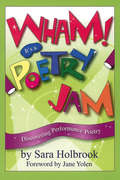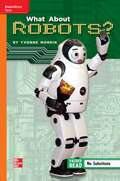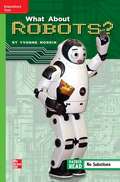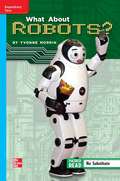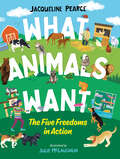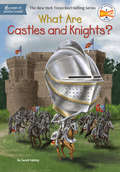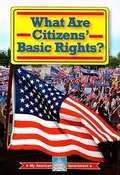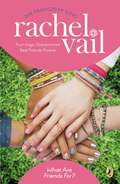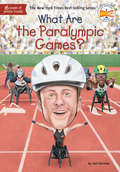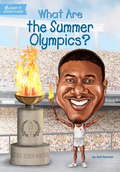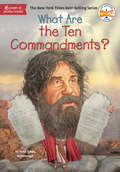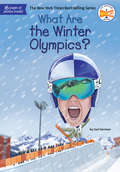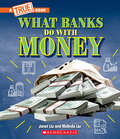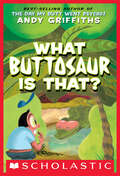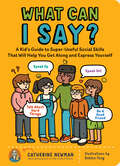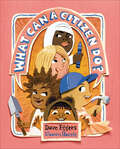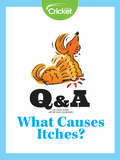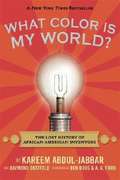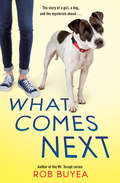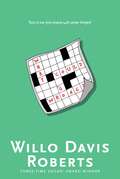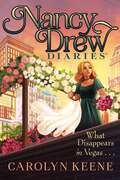- Table View
- List View
Whaling Season: A Year in the Life of An Arctic Whale Scientist (Scientists in the Field)
by Peter LourieIt's late April in Barrow, Alaska, which is about as far north in Alaska as you can get. The call comes in over the two-way radio - a crew has caught the first whale of the spring whaling season. Men, women, and teenagers jump on snow machines and drive out onto the ice to help harvest the whale, a tradition the Inupiaq Eskimos on Alaska's North Slope have followed for over two thousand years. John Craighead George, or Craig as he's called, heads out too. He is an Arctic whale scientist, and out on the ice with the whales and the whalers is just one of the places where an Arctic whale scientist works. <p><p> He and his colleagues have an agreement with the Inupiat to study these whales, bowheads. He has studied them for nearly thirty years and the mysteries of these large creatures never fail to amaze him. This installment in the Scientists in the Field series takes readers along with Craig, his wife, their colleages, and the Inupiat people as they go out on the ice and harvest whales. Lourie also details the happenings in Craig's ramshackle lab where he studies various organs and body parts, takes careful measurements, and crunches numbers. This is a real profile of what it is like to be a scientist living where he works, harvesting his own subjects, and using information passed down from generations of Eskimo culture to help him as he becomes the world's leading expert on bowhead whales. <p><p> Craig George is the son of legendary children's author Jean Craighead George, and it is easy to see that Craig grew up in a household where nature and human interaction went hand in hand. Author Pete Lourie's stunning photographs will transport readers to the top of the world, where the days and nights are long, the people respectful, and the whales are at the center of it all.
Wham! It's a Poetry Jam: Discovering Performance Poetry
by Sara HolbrookTake a wild ride with poet Sara Holbrook as she guides young writers in performing their poetry with style and pizzazz. With enthusiasm and a touch of irreverence, Ms. Holbrook, a performance poet herself, explains how to use voice, rhythm, attitude, movement, and other techniques to perform poetry in a group, duo, or solo. More than thirty poems are included for young readers to practice, as well as instructions for putting on a poetry jam at school or in the community.
What About Me?
by Colby RodowskyDorrie adores art. She is determined that she will graduate from high school in New York, and go on to art school. When her parents tell her that they will be leaving the city so that Dorrie's mother will have more help caring for Dorrie's younger brother who is developmentally delayed, Dorrie is furious. She is often resentful of the time and attention her parents devote to her brother, embarrassed by his odd behaviour, and angry that she is asked to make social sacrifices in order to help care for him, and this decision to move only fuels her anger and resentment. In the end, something happens that makes Dorrie reassess her feelings.
What Animals Want: The Five Freedoms in Action (Orca Think #3)
by Jacqueline PearceAll animals need food, water and shelter. But what about their social and emotional needs? Modern science tells us that animals experience a wide range of emotions—from fear and anxiety to friendship and happiness. What Animals Want is an animal-care book with a difference. It introduces young readers to the Five Freedoms and helps them think about their pets’ physical and emotional needs, providing a framework for thinking about the welfare of all animals in human care, including farm, exotic and wild animals. Author Jacqueline Pearce wrote this book in consultation with the British Columbia Society for the Prevention of Cruelty to Animals (BC SPCA), an organization internationally recognized for its innovative humane education and animal welfare work.
What Are Castles and Knights? (What Was?)
by Sarah Fabiny Who HQGo back to the thrilling time of warring knights who were prepared to give their life in order to protect their lord and his castle.Castles may conjure up a romantic fairy tale world; however, in real life, during the Middle Ages, castles were fortresses, providing shelter and protection for the lord as well as for the peasants who lived on his land. For an army, a lord depended on young soldiers in armor called knights who spent years at the castle learning the skills of warfare. Author Sarah Fabiny dives into the history of castles and how they grew from simple wood structures to mighty fortresses in stone. She also explains who could become a knight and what their lives were like off of the battlefield, enjoying feasts, courting their lady loves, and showing off in tournaments. With 80 fun black-and-white illustrations and an engaging 16-page photo insert, readers will be excited to read this latest addition to Who HQ!
What Are Citizens' Basic Rights? (My American Government)
by William David ThomasDescribes the civil rights guaranteed in the Constitution, especially the Bill of Rights, and discusses First Amendment rights, the rights of the accused, and the responsibilities of citizenship.
What Are Friends For?
by Rachel VailThe fourth book in bestselling author Rachel Vail's beloved Friendship Ring series! 4 rings, 1 promise: Best Friends Forever Olivia is the 'brain' of the group and she's not afraid to speak her mind. So when the rest of her friends gush over guys and clothes, she can't see what the big deal is. That sort of thing has never been important to her. Until she starts to have strange feelings for a boy in her class, made worse by the fact that her friend Morgan thinks he's a total dork. Now, Olivia finds herself keeping her feelings inside, when she knows she should just be honest with her friends.
What Are the Paralympic Games? (What Was?)
by Gail Herman Who HQIt's time to cheer for the inspiring athletes of the Paralympic Games! As the Opening Ceremony for the 1948 Summer Olympic Games commenced in London, a similar sporting competition was taking place a few miles away. But the men at Stoke Mandeville weren't your typical athletes. They were paralyzed World War II veterans. The games at Stoke Mandeville were so successful that they would eventually lead evolve into the Paralympics. Participants from all around the world vie for the gold medal in a variety of sports, including archery, basketball, swimming, speed skating, and ice hockey. Author Gail Herman highlights their achievements, describes how these athletes train--both mentally and physically--for the games, and gives the reader a better understanding of what makes the Paralympic Games one of the world's most viewed sporting events.
What Are the Summer Olympics?
by Gail Herman Stephen Marchesi Kevin McveighBack in 775 BC, athletes from all over Ancient Greece came together to compete in various games. The contests were held every four years and winning athletes brought honor and respect to their homelands.The tradition of the Olympic Games faded over time until 1896, when they were brought back to life. The first modern Olympics were held in Athens, Greece, with over two hundred athletes from fourteen countries. Today, nearly three thousand years after the first Games, the Summer Olympics attract one hundred thousand top athletes from over two hundred countries. Billions of fans around the world cheer on their national teams to bring back the gold.
What Are the Ten Commandments? (What Was?)
by Yona Zeldis Mcdonough Tim Foley Who HqLearn the story behind the ten laws that have been the guiding light of Judeo-Christian belief.Not just about Moses, whose origin story leaves open questions, this book looks back at the time when the commandments were written, how the belief in one all-powerful God set the Israelites apart from other ancient peoples, and the roles the Ten Commandments have played in Judaism, Christianity, and Islam. It also looks at what each individual commandment means and how together they form the basis of leading a moral life as well as forming a just government.
What Are the Winter Olympics? (What Was?)
by Gail Herman Who HQGrab your skis, ice skates, and snowboard and learn how the Winter Olympic Games became a worldwide phenomenal event watched by millions. Although fans the world over have been fascinated by the modern Summer Olympics since 1896, the Winter Olympics didn't officially begin until 1924. The event celebrates cold-weather sports, displaying the talents of skiers, ice skaters, hockey players, and, most recently, snowboarding. Like its summer counterpart, the Winter Games are dedicated to bringing together the world's top athletes to honor their talents and see who gets to stand on the medal podium. Gail Herman covers it all in a wonderful read--the highs, such as the 1980 US hockey team's unexpected gold medal grab, as well as the lows, including the Tonya Harding-Nancy Kerrigan figure-skating scandal in 1994. Includes 80 black-and-white illustrations and a 16-page photo insert.
What Banks Do with Money: Loans, Interest Rates, Investments... And Much More! (A True Book (Relaunch))
by Janet Liu Melinda LiuA series to build strong financial habits early on in life!Understanding how banks work - as well as the basics of loans and investments - are just two critical financial literacy skills that all kids should have. Did you know that banks use customers' deposits to make loans to other customers? Or that the Federal Reserve is the central bank of the United States? Learn all this and more in What Banks Do with Money - a book that introduces kids to banking.ABOUT THE SERIES:How can I make money? What is inflation? What is the difference between a debit card and a credit card? Economics - and more specifically, money - play such a large role in our lives. Yet there are many mysteries and misconceptions surrounding the basic concepts of finance and smart money management. This set of True Books offers students the know-how they'll need to start on the road to financial literacy-a crucial skill for today's world. Interesting information is presented in a fun, friendly way - and in the simplest terms possible - which will enable students to build strong financial habits early on in life.
What Buttosaur Is That? (Andy Griffiths' Butt Series)
by Andy GriffithsFrom the New York Times–bestselling author of the Butt Trilogy comes a silly and informative look at prehistoric butt-related life forms.Tyrannosore-arse Rex versus Tricerabutt: Who kicked more butt?Stenchtiles and Farthropods: Which smelled most foul?Exstinktion: How did the buttosaurs get wiped?This book will tell you everything you need to know but were too grossed out to ask about prehistoric butt-related life forms and the complex stenchology of their environment. Never again will you look like a fool when somebody asks, “What buttosaur is that?”A must-have for every kid with a butt!
What Can I Say?: A Kid's Guide to Super-Useful Social Skills to Help You Get Along and Express Yourself; Speak Up, Speak Out, Talk about Hard Things, and Be a Good Friend
by Catherine NewmanMiddle school is an essential time to learn and practice social skills, including how to get along with others, talk about hard things, be an ally, and a good friend. In What Can I Say?,Catherine Newman, author of the bestseller How to Be a Person, provides supportive guidance and instruction to help kids establish or and maintain meaningful relationships and effective communication with friends, teachers, family members, and others in their communities. Talking the talk can be tricky, and every page of this super-useful book provides easy, accessible scripts and guidance on the right thing to say in all kinds of situations, from how to be inclusive, listen, give advice, argue, stick up for yourself, and ask for help to how to turn down a date, express sympathy, deal with offensive comments, respond to bullying, and be trustworthy. Humorous, graphic-style illustrations that play our familiar scenarios reenforce Newman's friendly, non-judgmental tone and her commitment to helping kids develop the skills to express themselves clearly while showing empathy, care, and generosity towards others. This publication conforms to the EPUB Accessibility specification at WCAG 2.0 Level AA.
What Can a Citizen Do?
by Dave Eggers Shawn Harris&“[This] charming book provides examples and sends the message that citizens aren&’t born but are made.&” —The Washington Post This is a book about what citizenship—good citizenship—means: Across the course of several seemingly unrelated but ultimately connected actions by different children, we watch how kids turn a lonely island into a community—and watch a journey to what the world could be. With beautiful illustrations and rhyming text, What Can a Citizen Do? is the latest collaboration from the team behind Her Right Foot: New York Times–bestselling author Dave Eggers and acclaimed artist Shawn Harris. It&’s a delightfully engaging way for young readers to be inspired about the meaning of citizenship and the positive role they can play in our country and our world. &“Obligatory reading for future informed citizens.&” —The New York Times &“An absolute delight.&” —Maile Meloy, New York Times–bestselling author of Do Not Become Alarmed &“[A] must-have book.&” —School Library Journal
What Causes Itches?
by Lizzie WadeWhat causes itches, and how does scratching stop it? This Q & A explains what tells your brain you have an itch and how long to scratch.
What Color is my World: The Lost History of African-American Inventors,
by Raymond Obstfeld Kareem Abdul-JabbarWhile twins Ella and Herbie help the handyman Mr. Mital work on their new home, he tells them about such inventors as Granville Woods, Dr. Henry T. Sampson, and James West, giving them a new view of their heritage as African Americans.
What Comes Next
by Rob BuyeaFrom the beloved author of the MR. TERUPT and PERFECT SCORE series comes this stand-alone middle-grade novel about a girl who is dealing with the tragic loss of her best friend, and the dog that helps her forge new friendships and find happiness once again.Twelve-year-old Thea and her family are moving to a new town for a fresh start--her parents' bright idea. To Thea, it feels like running away. She lost her best friend, Charlie, in a tragic accident, and in the painful aftermath, she has gone mute. Her two younger sisters, however, are excited about moving, especially after their dad promises that the family will get a rescue puppy. This doesn't change Thea's mind, though, until Jack-Jack bounds into her life and makes it clear that he is no ordinary dog. As she bonds with Jack-Jack, and as the dog's mischievous ways steer her toward someone she can confide in, Thea opens up to the possibility of new friendships and forgiveness, and comes to believe in what cannot be fully explained.
What Could Go Wrong?
by Willo Davis RobertsGracie and her cousins find themselves in the midst of a summer vacation gone awry in this thrilling adventure from three-time Edgar Award-winning author Willo Davis Roberts.Everyone thinks Charlie is nothing but trouble, since bad things tend to happen whenever he's around. But Gracie knows better. Now both kids have the chance to fly with their other cousin Eddie from Seattle to San Francisco without any adults. Gracie's father isn't sure the trip is a great idea, but Gracie's not worried. What could go wrong? Then things begin to go wrong...very wrong! Is it just Charlie's bad luck following them? Or have Gracie and her cousins stumbled into something more dangerous than they could have ever imagined?
What Did The Ancient Chinese Do For Me? (Linking The Past And Present Series)
by Patrick Catel Megan Cotugno"From the seismograph to ice cream to fireworks, the Ancient Chinese continue to influence all aspects of contemporary life. Read this book to find out more about how we encounter links to the ancient world every day."
What Disappears in Vegas . . . (Nancy Drew Diaries #25)
by Carolyn KeeneA missing bride leads Nancy on a chase through Las Vegas in the twenty-fifth Nancy Drew Diaries, a fresh approach to a classic series.Bess and George&’s cousin Veronica is getting married to extreme sports enthusiast Xavier Redd, and as a close friend of the family, Nancy has been invited to the wedding. Given the groom&’s big personality and love for the extreme, the wedding will take place in Vegas, and the couple plan to take advantage of local sporting opportunities in the week leading up to the big event. Not everyone in the family approves of Veronica&’s fiancé, though, especially because of the risk-taking behavior Xavier has introduced her to. And when one of the couple&’s sporting stunts almost ends in a serious accident, it&’s not clear whether it&’s an unfortunate coincidence or whether someone really wants to stop the wedding from happening. Still, the day of the wedding arrives. But when it comes time to exchange vows, the bride is nowhere to be seen. Is this just a case of cold feet? Or has one of the wedding guests created a cold-hearted plot? One thing&’s for sure—Nancy won&’t rest until she finds out.

